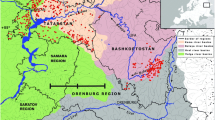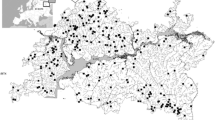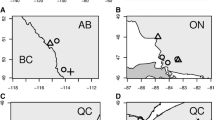Abstract
River plants were studied at 119 sites from a southern Iberian river basin. A site length of 50-100 m was found to be adequate for characterising local plant richness in these rivers. Average number of river plant species per site was 48 (range 21-76). Species richness showed a maximum at mid-course, with considerable variation in the upper course and a decreasing trend towards the floodplain. Sixteen environmental variables were initially considered to explain the biological variability. Nine, retained by the forward selection procedure, were significant predictors of the species distribution. Canonical correspondence analysis was used to directly relate plant species composition to these environmental variables. Altitude, conductivity, river width, pH, percentage of hard substrates and fine particulate organic matter on the river bed, average rainfall and temperature, and human-related disturbance were significantly related to the species distribution. Species positioned at the axes extremes could be arranged into species groups related to different geographical areas of the river system.
Similar content being viewed by others
References
Butcher, R. W., 1933. Studies on the ecology of rivers. I. On the distribution of macrophytic vegetation in the rivers of Britain. J. Ecol. 21: 58–91.
Demars, B. O. L. & D. H. Harper, 1998. The aquatic macrophytes of an English lowland river system: assessing response to nutrient enrichment. Hydrobiologia 384: 75–88.
Ferreira, M. T., 1992. Estrutura e dinâmica das comunidades de macrófitos lóticos da bacia hidrográfica do Sorraia. PhD Thesis. Agronomy Institute of Lisbon: 402 pp (in Portuguese).
Ferreira, M. T., 1994. Aquatic and marginal vegetation of the river Divor and its relation to land use. Verh. int. Ver. Limnol. 25: 2309–2315.
Ferreira, M. T. & F. Smeding, 1990. Distribution and patterns of aquatic and riparian vegetation in Erra river, central Portugal. Scientia Gerundensis 16: 116–125.
Ferreira, M. T., F. N. Godinho & R. M. Cortes, 1998. Macrophytes in a southern Iberian river. Verh. int. Ver. Limnol. 26: 1835–1841.
Haslam, S. M., 1987. River plants of western Europe: the macrophytic vegetation of watercourses of the European economic community. Cambridge University Press, Cambridge: 512 pp.
Haury, J., M. C. Peltre, S. Muller, M. Tremolieres, J. Barbe, A. Dutartre & M. Guerlesquin, 1996. Des indices macrophytiques pour estimer la qualite des cours d'eau français: premieres propositions. Ecologie 27: 233–244 (in French).
Hills, J. M., K. J. Murphy, I. D. Pulford & T. H. Flowers, 1994. A method for classifying European riverine wetland ecosystems using functional vegetation groups. Funct. Ecol. 8: 242–252.
Holmes, N. T. H., P. J. Boon & T. A. Rodwell, 1988. A revised system for British rivers based on their aquatic communities. Aquat. Conserv.: Mar. Freshwat. Ecosyst. 8: 555–578.
Nilsson, C. & R. Jansson, 1995. Floristic differences between riparian corridors of regulated and free-flowing boreal rivers. Regul. Riv., Res. Mgmt 11: 55–66.
Nilsson, C., A. Ekblad, M. Dynesius, S. Backe, M. Gardfjell, B. Carlberg, S. Hellqvist & R. Jansson, 1994. A comparison between species richness and traits or riparian plants between a main river channel and its tributaries. J. Ecol. 82: 281–295.
Nilsson, C., G. Grelsson, M. Johansson & U. Sperens, 1988. Can rarity and diversity be predicted in vegetation along river banks? Biol. Conserv. 44: 201–212.
Penuelas, J. & F. Sabater, 1987. Distribution of aquatic macrophytes in relation to environmental factors in the Ter river, N.E. Spain. Int. Rev. ges. Hydrobiol. 78: 41–58.
Rodwell, J. S., C. D. Pygott, D. A. Ratcliffe, A. J. Malloch, H. J. Birks, M. C. Proctor, D. W. Shimwell, J. P. Huntley, E. Radford, M. J. Wigginton & P. Wilkins, 1995. British plant communities. Volume 4. Cambridge University Press: 283 pp.
Tabacchi, E., A. M. Planty-Tabacchi, M. J. Salinas & H. Decamps, 1996. Landscape structure and diversity in riparian plant communities: a longitudinal comparative study. Regul. Riv., Res. Mgmt 12: 367–390.
Ter Braak, C. J. F. (1990) CANOCO version 3.1. Update notes. Agricultural Mathematics group, Wageningen: 35 pp.
Wiegleb, G., 1988. Analysis of flora and vegetation in rivers: concepts and applications. In Symoens, J. J. (ed)., Vegetation of Inland Waters. Handbook of Vegetation Science no 15. Kluwer Academic Publishers, Dordrecht, The Netherlands: 311–340.
Author information
Authors and Affiliations
Corresponding author
Rights and permissions
About this article
Cite this article
Ferreira, M.T., Moreira, I.S. River plants from an Iberian basin and environmental factors influencing their distribution . Hydrobiologia 415, 101–107 (1999). https://doi.org/10.1023/A:1003837802366
Issue Date:
DOI: https://doi.org/10.1023/A:1003837802366




